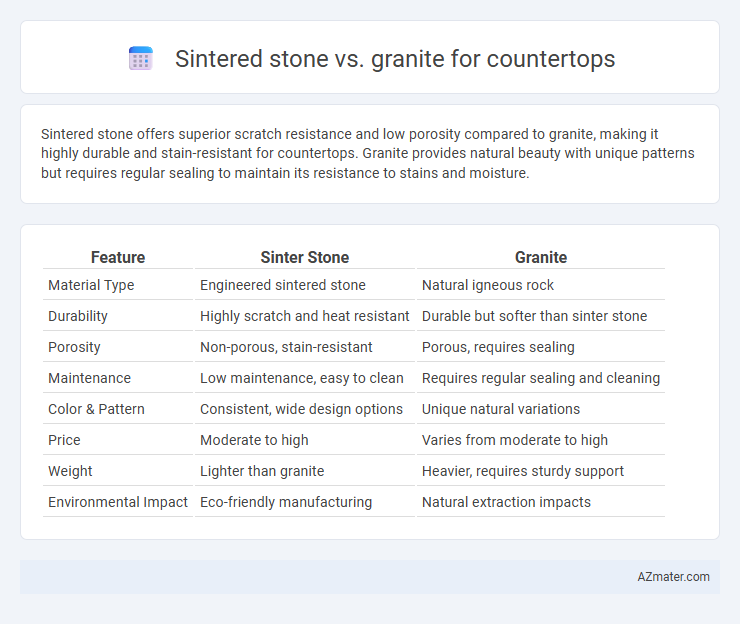Sintered stone offers superior scratch resistance and low porosity compared to granite, making it highly durable and stain-resistant for countertops. Granite provides natural beauty with unique patterns but requires regular sealing to maintain its resistance to stains and moisture.
Table of Comparison
| Feature | Sinter Stone | Granite |
|---|---|---|
| Material Type | Engineered sintered stone | Natural igneous rock |
| Durability | Highly scratch and heat resistant | Durable but softer than sinter stone |
| Porosity | Non-porous, stain-resistant | Porous, requires sealing |
| Maintenance | Low maintenance, easy to clean | Requires regular sealing and cleaning |
| Color & Pattern | Consistent, wide design options | Unique natural variations |
| Price | Moderate to high | Varies from moderate to high |
| Weight | Lighter than granite | Heavier, requires sturdy support |
| Environmental Impact | Eco-friendly manufacturing | Natural extraction impacts |
Introduction: Sinter Stone vs Granite for Countertops
Sinter stone and granite are popular materials for countertops, each offering distinct benefits in durability and aesthetics. Sinter stone is engineered through high-pressure sintering technology, making it highly resistant to scratches, stains, and heat, while granite is a natural stone known for its unique patterns and robust physical strength. Choosing between sinter stone and granite depends on preferences for maintenance, design variety, and long-term investment in kitchen or bathroom surfaces.
Composition and Manufacturing Process
Sinter stone is made from natural minerals compressed at extreme heat and pressure through a sintering process, resulting in a dense, non-porous surface with enhanced durability and resistance to stains and scratches. Granite is a natural igneous rock composed primarily of quartz, feldspar, and mica, quarried and then cut and polished for countertop use, making each slab unique with natural variations and inherent porosity. The manufacturing of sinter stone involves advanced technology that ensures uniformity and consistency, while granite's manufacturing relies on traditional quarrying and finishing techniques that preserve its natural characteristics.
Appearance and Design Variety
Sintered stone offers a sleek, uniform appearance with a broad spectrum of colors and patterns, mimicking natural materials like marble and quartz with enhanced durability. Granite showcases unique, natural veining and speckled textures, providing each slab with a distinct, one-of-a-kind look favored for traditional and rustic designs. Both materials cater to diverse design preferences, but sintered stone excels in offering consistent aesthetics with high customization options.
Durability and Strength Comparison
Sinter stone offers exceptional durability due to its high resistance to scratches, stains, and heat, making it ideal for heavy kitchen use. Granite is a natural stone known for its remarkable strength and toughness but may require regular sealing to maintain its durability against moisture and staining. Both materials provide strong surfaces, yet sinter stone's non-porous composition enhances its longevity and low maintenance compared to granite.
Stain and Scratch Resistance
Sintered stone offers superior stain resistance compared to granite due to its non-porous surface that prevents liquids from seeping in, making it ideal for kitchens prone to spills. Granite, while naturally durable, requires regular sealing to maintain its resistance against stains and can be more susceptible to etching from acidic substances. In terms of scratch resistance, sintered stone is engineered for high hardness, providing excellent protection against knife marks and abrasions, whereas granite may show wear over time, especially if softer mineral spots are present.
Heat and UV Resistance
Sintered stone exhibits superior heat resistance, withstanding temperatures up to 1,200degC without damage, making it ideal for kitchen countertops exposed to hot pots and pans. Granite also offers strong heat resistance but can suffer thermal shock if exposed to sudden temperature changes, risking cracks or discoloration. Sintered stone uniquely provides exceptional UV resistance, maintaining color and structural integrity when exposed to sunlight, while granite may fade or weather over time when placed in direct sunlight.
Maintenance and Cleaning Requirements
Sintered stone countertops require minimal maintenance due to their non-porous surface that resists stains and bacterial growth without the need for sealing, unlike granite which often demands periodic sealing to prevent absorption of liquids and staining. Cleaning sintered stone is straightforward with just mild soap and water, while granite requires gentle cleaners and avoiding acidic or abrasive products to maintain its finish. The durability of sintered stone also means it resists scratches and heat better, reducing the frequency of repairs compared to granite countertops.
Cost and Value Analysis
Sintered stone countertops typically cost between $60 to $100 per square foot, offering superior durability, stain resistance, and low maintenance compared to granite, which ranges from $40 to $70 per square foot depending on the grade and origin. While granite provides a natural, classic aesthetic with unique veining, sintered stone delivers enhanced resistance to heat, scratches, and UV rays, making it more cost-effective over time due to its longevity and minimal upkeep. Homeowners seeking a balance between upfront investment and long-term value often find sintered stone a better financial choice despite its higher initial price.
Environmental Impact and Sustainability
Sintered stone countertops have a lower environmental impact compared to granite due to their production process, which uses natural minerals fused at high temperatures without harmful chemicals or resins. Granite extraction involves mining and quarrying, leading to habitat disruption and significant energy consumption. Sintered stone's durability and recyclability contribute to its sustainability, making it a more eco-friendly option for countertops.
Which Countertop Material Is Right for You?
Sinter stone offers exceptional durability, heat resistance, and low porosity, making it highly resistant to stains and scratches, which suits busy kitchens requiring minimal maintenance. Granite provides unique natural patterns and strong heat resistance, but it requires periodic sealing to prevent staining and is prone to chipping in high-impact areas. Choosing between sinter stone and granite depends on your preference for maintenance level, aesthetic appeal, and durability requirements for your countertop.

Infographic: Sinter stone vs Granite for Countertop
 azmater.com
azmater.com